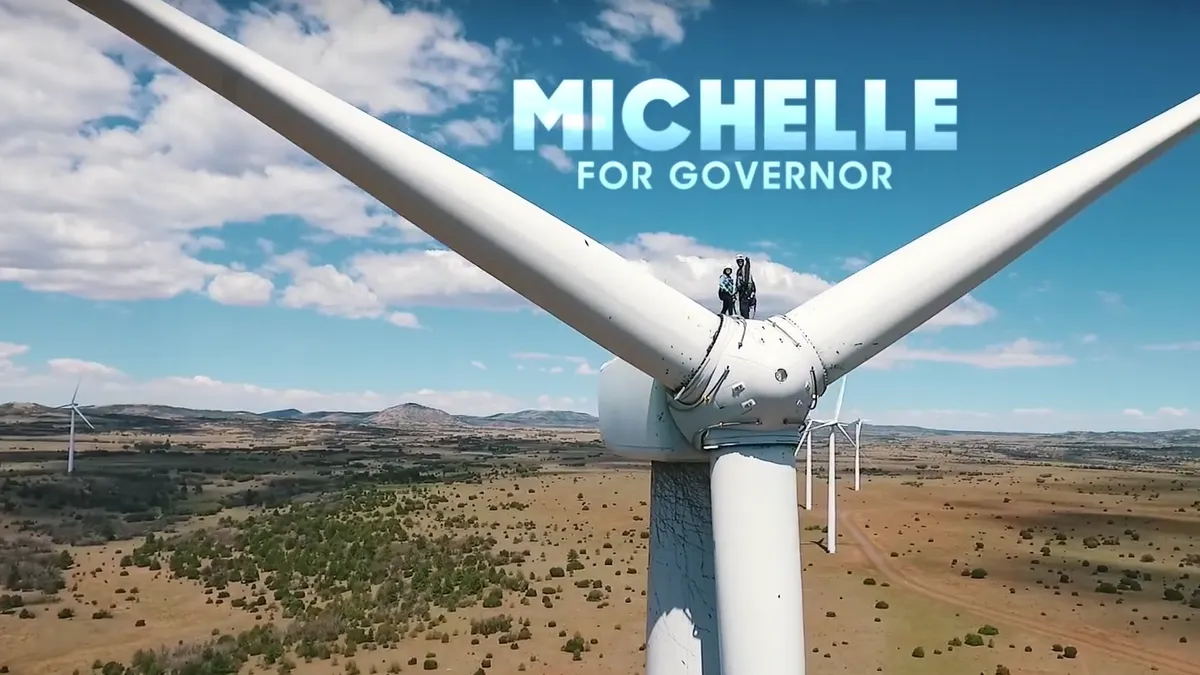"You don't see a lot of candidates for governor out here. Much less one willing to climb a 26-story ladder. But Michelle is no usual candidate."
That was the message that then-candidate Michelle Lujan Grisham famously sent in a campaign video that showed her climbing a wind turbine when she was running for governor in 2018. During that election cycle, the governor's chair flipped Republican to Democrat in seven states, with all of the Democratic candidates demonstrating strong support for clean energy.
"We had a Republican governor for eight years, and our voters made it clear last November that they weren’t satisfied with what happened during those years," the governor told Utility Dive in an email.
"New Mexicans know that a comprehensive approach to combating climate change and transitioning to clean energy is the only path forward."
Leading the path to 100%
Lujan Grisham set the tone on clean energy within her first 30 days in office, signing an executive order Jan. 29 that called for the state to cut economy-wide emissions 45% below 2005 levels by 2030.
"It wasn't just a broad commitment to achieving climate reductions at some future date with some policies unknown, but really laid out a pretty clear roadmap of the kinds of tools that the state would start to work on immediately," Noah Long, Natural Resources Defense Council Director of the Interior West and North West Climate and Clean Energy Program, told Utility Dive after the order was signed. "That really, I think, sets it as the gold standard for gubernatorial leadership on climate action and I think the sort of bar that we'll be looking to see other governors step up to."
And on March 22, she signed into law the Energy Transition Act, mandating New Mexico generate 100% of its electricity from carbon-free resources by 2045.
Lujan Grisham acknowledges that fossil fuels have produced a lot of benefits to her state in the form of taxing energy producers to extract the state's oil, gas and coal resources.
But, "Big picture: Where has it gotten us?" she asked. "New Mexico remains a high poverty state with a slew of seemingly intractable problems. So maybe it’s time we try something new."

Transitioning the state's economy could include a number of approaches. For example, a Santa Fe-based data company is developing monitoring solutions for methane leaks, a technology that "will cross state borders," she noted.
And regardless of what technology will get the state there (she's leaving that one up to scientists) she knows more electric generation across the board will be needed to fully move the state away from fossil fuels. To make that happen, more wind and solar power will be needed.
"New Mexico is second in the country in solar potential and third in wind energy production — this is a state uniquely positioned to capitalize on renewable energy," she said.
Getting over coal
As with any administration, Lujan Grisham's just-under-a-year tenure has not been without controversy. Though widely supported by utilities, clean energy and labor groups, the ETA has received pushback, including from regulators, largely centered on the 847 MW San Juan coal plant in Farmington, New Mexico.
"... all legislation is based on compromise, and the ETA seeks to treat all New Mexicans — whether coal plant workers or investors — fairly."

Michelle Lujan Grisham
Governor, New Mexico
Local groups are afraid that retiring the plant early will harm Farmington's economy, which relies heavily on the $70 million per year in salaries and benefits the plant provides, the city's mayor told Utility Dive in August. Meanwhile, other groups are happy the plant is retiring, but unhappy the state's largest utility, the Public Service Company of New Mexico (PNM), is not forced to bear the full brunt of what they say was a bad investment in the first place.
"That argument is not without merit," she said, "but all legislation is based on compromise, and the ETA seeks to treat all New Mexicans — whether coal plant workers or investors — fairly."
But at the end of the day, transitioning her state's reliance on fossil fuels remains a priority for her and other state leaders across the country.
"While the federal government continues to bury its head in the sand and deny the impacts of climate change, states have to lead the charge, and that’s exactly what we’re doing here in New Mexico," she said.




 Read more
Read more










